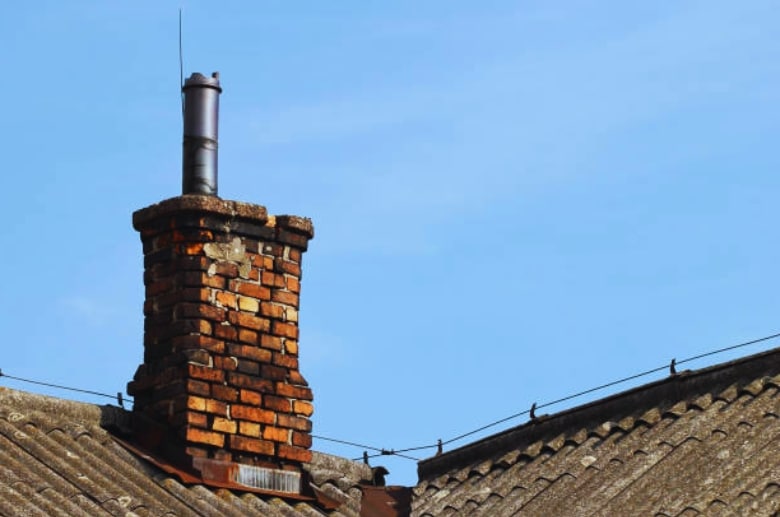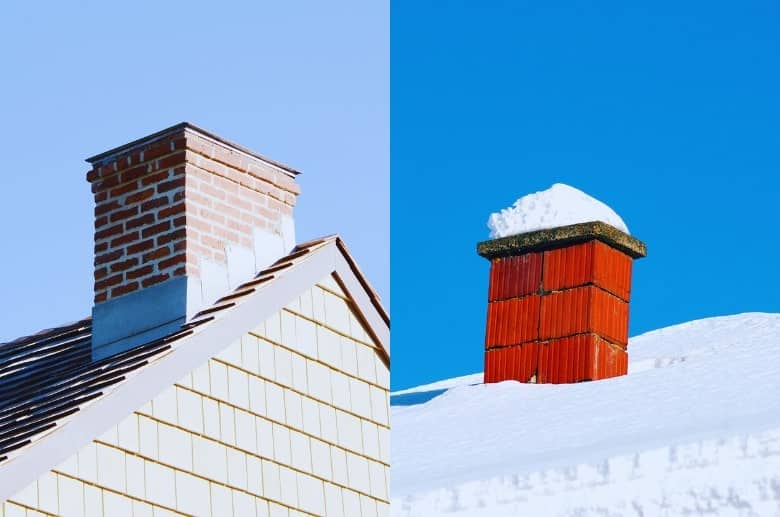While a properly functioning chimney is a blessing on cold winter nights, a cracked chimney poses extreme dangers to you and your loved ones. For instance, a cracked chimney can allow harmful gases, like carbon monoxide, to leak through the brick or the fireplace.
These gases can be incredibly toxic for you and your loved ones. They can cause short to long-term health problems, including dizziness, nausea, and lung disease. Children, the elderly, and people with asthma are more at risk if exposed to such gases, but everyone is at risk of the deadly poisoning known to take lives.
A chimney crack also acts as an entry point for small birds, pests, or even rodents to enter your house. Apart from these dangers, a cracked chimney will allow water to enter your house through various parts of the chimney structure, possibly harming and compromising the integrity of your chimney and fireplace.
One of the underlying causes of such cracks can be a compromised chimney foundation, which, if not built or maintained properly, can lead to structural issues.
Since chimney cracks pose grave risks, homeowners should stay vigilant and call a professional service if they notice any warning signs. But first, it’s important to answer the question: what causes a chimney to crack
What Causes a Chimney to Crack?
Let’s take a look at the most common causes of chimney cracks.
1. Water Damage
Water damage is the biggest culprit behind chimney cracks. You should watch out for the following signs of water damage:
- Discoloration on the exterior of your chimney.
- Signs of moisture or water on your chimney.
- A white, powdery substance known as efflorescence may sit on your chimney masonry after the water has evaporated.
- Cracks or gaps between the bricks.
——
Do You Need to Hire Chimney & Fireplace Expert?
Get free quotes from qualified experts near you. No commitment required!
——
To combat this issue, you can have a chimney inspection by trained professionals every year (according to the NFPA 211 guidelines) so they can tell whether there is a leak in your chimney. You can also install a chimney cap. It will cover the top of your chimney and prevent water from entering your chimney. If you have a chimney cap, water won’t enter your chimney the next time it rains.
2. Heat and Moisture

If you live in an area that experiences torrential rains, heavy snow from time to time, other serious weather events, or high humidity – your chimney will always be at risk of getting cracks.
Water moving through your chimney may evaporate and leave crystalized pieces of salt, known as efflorescence. This worsens the cracking process by directly weakening the chimney mortar.
To prevent this, clean your chimney regularly to stop the movement of moisture from creating cracks outside and inside.
3. Structural Issues

Calling in a cheap builder may save you some money in the short run, but it’ll cost you an arm and a leg when you hear about the possible problems you might run into, thanks to shoddy construction.
A chimney with inconsistently sized stone, brick, or mortar cannot shoulder its weight for long. Since the structure is not solidly intact, cracks will form in places. The materials will crumble and fall off, putting you and your loved ones at risk.
Another common structural problem may be the quality of the materials used to make brick chimneys. If the chimney brick is low-grade, it will eventually succumb to the weight of the chimney.
Wear and tear may also contribute to the cracks in your chimney. This is why proper and regular chimney cleaning is necessary. This service prevents debris buildup and stops the chimney from getting clogged.
Here are some tips to maintain your chimney’s structure:
- Inspect your chimney regularly. Keep an eye out for cracks or gaps in your chimney. If you notice small cracks, immediately repair or fix them using a proper sealant and caulk gun. But if the cracks are larger, it’s best to call a chimney repair expert to fix the issue by addressing its root cause. This will not only prevent cracks from getting worse but also prevent underlying structural issues.
- Use a chimney cap. A well-fitted cap will prevent rainwater from seeping inside your chimney. If you already have a chimney cap, ensure it’s not cracked or misplaced.
- Schedule a professional inspection. Relying on professionals with solid experience to thoroughly inspect your chimney (at least once per year) is perhaps your best bet to avoid costly structural issues down the road.
4. Freeze-Thaw Cycles

The freeze-thaw cycle is a common problem homeowners face with their chimneys.
As water freezes and thaws, it can wreak havoc on your chimney’s structural integrity. The repeated expansion and contraction caused by this cycle can lead to serious damage, including cracks and gaps in the chimney’s mortar joints.
These structural issues can worsen and pose significant safety hazards if left unchecked. Therefore, it’s crucial to be aware of the freeze-thaw cycle and take steps to prevent and address any resulting chimney structural problems.
5. Thermal Shocks
When there is a sudden temperature change, the material of the chimney does not have enough time to return to its normal temperature. This sudden temperature variation is known as a thermal shock.
Thermal shocks cause sudden contraction and expansion in chimneys, which are detrimental to their structural integrity. But why does this cause such a problem?
When you burn coal or wood, the chimney starts to heat up. The material of the chimney then expands rapidly. Porous bricks tend to absorb moisture. The chimney’s heating can cause quick temperature changes, leading to thermal shock and a chimney crack.
Most of these causes, if not all, are working in the background and are not obvious. That is why, as a homeowner, you need to stay vigilant of the warning signs of a damaged chimney. If you notice any of these signs, call a professional service to inspect your chimney and solve the issue before serious damage occurs.
Types of Chimney Cracks
Are you curious about that chimney crack you found in your chimney? What caused it? Let’s help you identify just that.
——
Do You Need to Hire Chimney & Fireplace Expert?
Get free quotes from qualified experts near you. No commitment required!
——
Hairline Cracks
Generally, hairline cracks shouldn’t make you worry too much. They are thin, small cracks that you may not even notice. Upon close inspection of your chimney bricks, you may notice a thin crack running from one end to another.
Hairline cracks are often caused when water enters the chimney through rain or leakage. Leaks can be quickly dealt with by applying a water repellent (such as silane-siloxane).
If the hairline crack is caused by vegetation or plants, use a herbicide to eliminate the problem. Remember, just cutting the plant away won’t be enough.
In some cases, hairline cracks can result from settlement of the ground around the chimney. If that’s the case, have a chimney expert look at the chimney’s footing to ensure the pressure of the chimney’s weight isn’t too much.
If there is a hairline crack in the chimney breast, never ignore it. It presents a bigger threat than a hairline crack in other parts of the chimney. If hairline cracks are not fixed, they may worsen with time.
Therefore, it’s best to call in for a professional to have your hairline cracks sealed or repaired. If the cracks are minor, you can use a silicone sealant to ensure the problem doesn’t worsen. Sometimes it will be necessary to employ the help of professional masons.
Vertical Cracks

Vertical cracks usually occur when there is a shift in temperature or when the foundation is poorly built. These cracks go up and down, and you can notice them easily.
Vertical cracks present a bigger problem because flames or embers may escape through these cracks, possibly causing a fire. Moreover, harmful gases (e.g., carbon monoxide) may escape through the cracks, posing a health hazard to your loved ones.
We don’t recommend fixing vertical cracks yourself, since this can be difficult. You may miss a few cracks, compromising the chimney’s structure. A professional will inspect the whole chimney, identify the root issue and make the necessary repairs.
Horizontal Chimney Cracks
Horizontal cracks are caused by moisture. These cracks are typically caused by water damage or the classic freeze-thaw cycle. If you live in an area with ample rainfall throughout the year, you might see these cracks on your chimney.
Horizontal cracks are worse than vertical cracks because they weaken the chimney’s structure and make it vulnerable to collapse. A structurally weak or leaning chimney poses a severe risk of property damage and puts the safety of your loved ones at stake. Horizontal cracks can also pose a carbon monoxide threat and a fire hazard.
These cracks show that your chimney is doing far worse than you think. Steel braces may be used to reinforce the structure of the chimney. But if there are multiple horizontal cracks, you might want to have the whole portion reconstructed.
Larger Cracks
Larger cracks present a major issue in your chimney’s structure. A large crack must be repaired and cared for by a professional before things worsen. Large chimney cracks might be caused by: wear & tear, climate impact, and improper installation.
Sometimes a large crack is the clear result of a catastrophic event, such as earthquakes, lightning strikes, hail storms, strong winds, or even a house fire. These brick chimney cracks are usually not in isolation; there will probably be other issues with your home, such as damage in the attic or breaks in any nearby concrete block.
Do not take a large crack lightly, since this means the chimney cannot hold out for long. There could also be damage you can’t see, such as breaks in the chimney flue or instability in the chimney footing. We strongly recommend you contact an expert for help right away.
What To Do If You Suspect Chimney Cracks?
If you suspect cracks in your chimney, follow the steps below:
- Conduct regular chimney inspections. Hire a masonry contractor or a professional chimney company to find and fix chimney cracks or defects. This is perhaps the easiest and safest advice to follow.
- Get to the root of the issue. You may get your chimney cleaned or repaired, but what if the root issue isn’t addressed? If your chimney’s surrounding areas or your roof has a water leak, it is in your best interest to fix this issue first. Otherwise, the circumstances will remain the same, and you will have problems with chimney cracks again.
- Don’t try to fix it alone. We strongly discourage homeowners from repairing chimney cracks on their own. You might end up falling or causing more harm to the chimney. Broken pieces of bricks or mortar may land in your eyes or hurt your head. So it’s best to call a professional chimney sweep for help.






